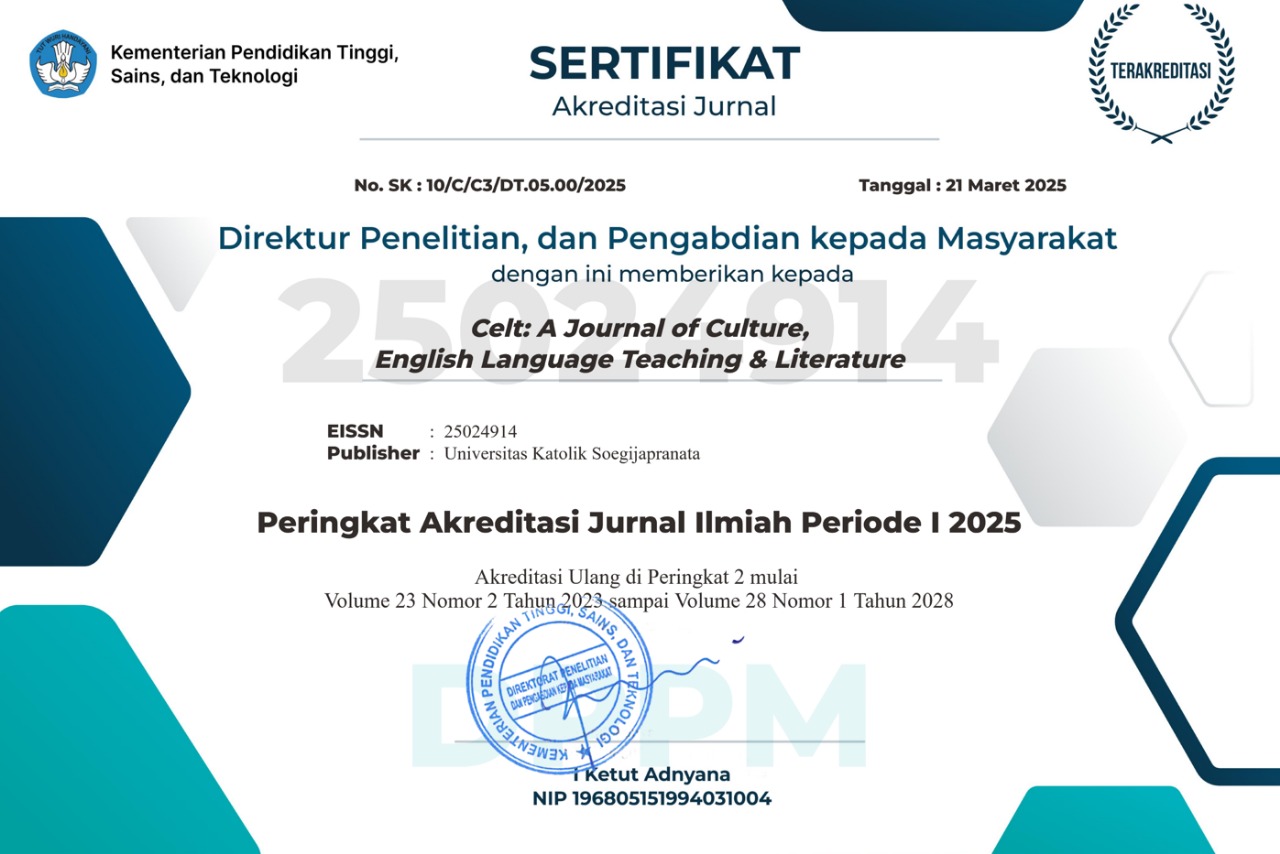PACA (Predicting And Confirming Activity) Reading Strategies to Promote Students’ Teaching Strategy in TEFL 1 Class
Abstract
Keywords
Full Text:
PDFReferences
Al-Tamimi, N. O. (2006). The effect of direct reading strategy instruction on students’ reading comprehension, metacognitive strategy awareness, and reading attitudes among eleventh grade students in Yemen (Unpublished doctoral dissertation, University Sains Malaysia).
Amaya, M. J. (2001). Implementing a content-based language teaching programme. In G. Sánchez (Ed.). Present and Future Trends in TEFL. Almería: Universidad de Almería, 135-165.
Ananthakrishnan, N. (1993). Microteaching as a Vehicle of Teacher Training-its Advantages-Disadvantages. Journal Postgraduate Medicine, 39(3), 142.
Baytekin, Ç. (2004). Learning Teaching Techniques and Material Development. Ankara: Ani Yayincilik.
Beydogan, Ö. (2002). Changes in teaching strategies and the changing role of teachers. Çağdaş Eğitim, 27(287), 34-39.
Bircan, I. (2003). New Directions in Education: Elementary School Teacher education in Developed Countries. Sivas: Cumhuriyet Üniversitesi.
Bowen, T. (2006). Methodology Challenge. The Communicative Classroom. Onestopenglish, Macmillan.
Celep, C. (2001). Teacher-Student Relationship in Classroom Management. Çağdaş Eğitim, 26(272), 19-24.
Creswell, J. W. (2003). Research Design: Qualitative, Quantitative, and Mixed Methods Approaches (2nd ed.). Sage Thousand Oaks.
Danasasmita, W. (2007). Efektivitas Model Directed Reading Actvity (DRA) Dalam Pengajaran Membaca Bahasa Indonesia Sebagai Bahasa Asing [The Effectiveness of the Directed Reading Activity (DRA) Model in Teaching Indonesian Reading as a Foreign Language]. Jurnal Educationist, 1(2).
Degu, G., & Yigzaw, T. (2006). Research Methodology: Lecture Notes for Health Science Students. Addis Ababa: The Carter Center (Ethiopian Public Health Training Initiative), 45-50.
Delgado, J. (2005). Engaging Strategies for All Students: The SpringBoard Reading Strategies. New York: The College Board.
Dillon, J., & Maguire, M. (Eds.). (1997). Becoming a Teacher. Issues in Secondary. Buckingham: Open University Press.
ERIC. (2000). Making large Classes More Interactive. No. EJ610221.
ESL Glossary. ESL Glossary: Definitions of common ESL/EFI terms: Communicative Approach. Retrieved on 25 October, 2012 from www.bogglesworld.com/glossary/communicativeapproach.htm
Gottlieb, S. (2004). Innovative Assessment in Competency Based Student Centered Learning. Adapazari, Sakarya: Esentepe Campus of Sakarya University.
Hanušová, S. (2004). Methodology: The Grammar-Translation Method. Faculty of Education, Brno.
Harmer, J. (1995). The Practice of English Language Teaching. Harlow: Longman House.
Hoffman, J.V., Baumann, J.F., & Afterbach, P. (2000). Balancing Principles for Teaching Elementary Reading. New Jersey: Lawrence Erbaum Publkisher.
Isman, A. (2003). Teaching Technologies and Material Development. Istanbul: Degişim.
Katchen, J. E. (2004). Teaching Presentation Skills Using Video as Role Model. In Proceedings of the MOE Conference on “Developing the Basics of Holistic General Education (pp. 41-50). Xinfeng, Hsinchu: MingHsin University of Science and Technology.
Kinsella, K. (2001). Mathematics Reading Strategies. California: Globe Fearon, Pearson Learning Group.
Larsen-Freeman, D. (1986). Teachiques and Principles in Language Teaching. Oxford: Oxford University Press.
Miles, R. (2009). Oral Presentation for English Proficiency Purposes. Reflections on English Language Teaching Journal, 8(2), 103–110.
Nunan, D. (2000). Language Teaching Methodology: A textbook for teachers. London: Pearson Education Ltd.
Oddens, D. A. M. (2004). Trend in Ducth Vocational Education Teacher Training in Terms of Personal Quality. In International Conference on VET Teacher Training (Vol. 1, pp.347-354). Ankara: SVET.
Otto-Van. (2004). Oral Presentation Rubric. Leistungskuis English K13/¸-2004/06 (Numberger). Van Taube Gymnasium.
Patton, M. Q. (1990). Qualitative evaluation and research methods. London-Newbury Park, New Delhi: SAGE Publications, Inc.
Pinnell, G. S., & Fountas, I.C. (1998). Word Matterrs; Teaching Phonics and Spelling in the Reading/Writing Classroom. Portsmouth, NH: Heinemann.
Rayner, K., Foorman, B. R., Perfetti, C. A., Pesetsky, D., & Seidenberg, M. S. (2001). How psychological science informs the teaching of reading. Psychological science in the public interest, 2(2), 31-74.
Richard. (2006). Total Physical Response. British Council: BBC World Service. Retrieved from www.teachingenglish.org.uk/think/methodology/tpr.shtml
Richards, J. C., & Rodgers, T. S. (2003). Approaches and methods in language teaching. Cambridge university press.
Scrivener, J. (1994). Learning Teaching. Oxford: Macmillan Publisher Limited, 1-19.
Sisman, M. & Acat, B. (2003). The Effect of Teaching Practicum on the Perception of Teaching Prtofession. Firat Üniversitesi Sosyal Bilimler Dergisi, 13(1), 235-250.
Sisman, M. (2001). Introduction to Teaching. Ankara: Pegema Yaytnctltk.
Stern, H. H. (1983). Fundamental Concepts of Language Teaching. Oxford University Press.
Vianty, M. (2007). The Comparison of Students’ Use of Metacognitive Reading Strategies between Reading in Bahasa Indonesia and in English. International Education Journal, 8(20), 449-460.
Wallace, A. E. (2005). The Impact of Implementing Four Specific Reading Strategies (Outlining, SQ3R, PLAN, and PACA) On the High School Geography Classroom. Shawnee Mission East High School. Shawnee Mission Board of Education.
Woods, P., Jeffrey, B., Troman, G. & Boyle, M. (1997). Restructuring Schools, Reconstructing Teachers. Buckingham: Open University Press.
DOI: https://doi.org/10.24167/celt.v18i1.893
Copyright (c) 2018 Celt: A Journal of Culture, English Language Teaching & Literature
| pISSN (print): 1412-3320 | eISSN (online): 2502-4914 |











